Two European Research Groups Launch Certification Systems for AI: Self-Driving Cars Need Driver’s Licenses
Munich. The German Research Center for Artificial Intelligence (DFKI) and TÜV SÜD are launching a joint project to certify systems based on artificial intelligence (AI) used in autonomous driving and develop a ‘roadworthiness test’ for algorithms. To do so, the experts will explore the learning behaviours of AI systems with the aim of being able to control the systems’ reactions. The main objective is to develop an open platform, known as ‘Genesis’, for OEMs, suppliers and technology companies. The platform will be able to validate artificial intelligence modules and thus provide the basis for certifications. The project highlights TÜV SÜD’s claim to the status of leading independent testing and certification organisation in the development of autonomous driving.
“TÜV SÜD has been engaged in advancing the safety and public acceptance of technical innovations for over 150 years, and autonomous driving is no exception. We are delighted to be working with the DFKI on making tomorrow’s driving safer and embracing the challenges presented by artificial intelligence”, says Dr. Houssem Abdellatif, Global Head Autonomous Driving at TÜV SÜD. AI systems are becoming increasingly prevalent in the electronics systems of autonomous vehicles, helping the vehicles to safely master the enormous number of potential traffic situations that may occur – a number that TÜV SÜD’s experts have estimated at 100 million for each fully automated driving function. Such systems do not react in a deterministic manner, and are thus not exactly predictable; instead, they learn from traffic situations in a process known as ‘deep learning’, and draw their own conclusions to deliver the correct reaction. In other words, they make autonomous decisions. To ensure their decisions are always favourable to the safety of the traffic around them, TÜV SÜD plans to validate and certify the underlying algorithms. Dr. Abdellatif explains, “As yet we know very little about exactly how AI systems learn. This is ground-breaking work.” The aim is for users of the new Genesis platform to upload their data and modules for testing in future; systems that pass will be awarded the appropriate TÜV SÜD certificate for functional safety.
Dr. Christian Müller, Head of Team Autonomous Driving ASR & Competence Center Autonomous Driving CCAD at DFKI, affirms, “The industry has shown enormous interest, with many companies already gearing up to take part in Genesis. We are delighted to have TÜV SÜD on board, as a prestigious partner that is synonymous with international vehicle and road safety.”
Driving test for autonomous vehicles
The difficulties involved in developing methods for the safety of AI systems are obvious. AI systems use the available data to draw their own conclusions, and successively learn from every time they encounter traffic situations. In this respect they are similar to learner drivers. The certainty that a vehicle will react correctly in traffic thus continuously increases over time. The experts’ objective is to be able to evaluate the system’s learning progress in a process similar to the theory examination of a driving test. Dr. Abdellatif notes, “Results achieved to date by the deep learning method have shown surprisingly good results in practice, yet still nobody knows how the process actually works. This is what our joint project will now investigate.”
But a practical test is also essential before autonomous vehicles can get the green light for road use. Here, the experts will need to explore the process by which AI systems learn. “Once we understand exactly what conclusions the systems draw, we can intervene to control their learning in a targeted manner. We need to know not just whether a vehicle will brake, but why”, says Dr. Abdellatif. Taking motorway overtaking as an example: the autonomous vehicle moves into the overtaking lane to pass a truck, but another vehicle is approaching at high speed from behind. Will the autonomous vehicle brake before passing into the cruising lane immediately after overtaking, or will it adjust its own speed and accelerate? “Our work in the years ahead will be to address questions like these and discover the answers”, says the expert. Data collected from virtual traffic situations will be used to monitor and correct the algorithms’ learning process. The final result will be a certificate, or ‘driving licence’, for an algorithm, which confirms it is safe for road traffic.











